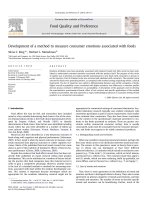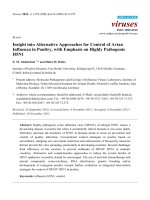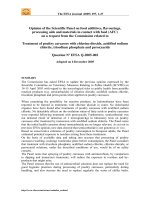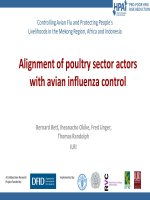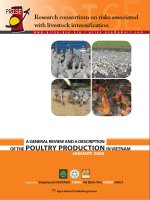CRTM-2: Maize with effective tillering trait
Bạn đang xem bản rút gọn của tài liệu. Xem và tải ngay bản đầy đủ của tài liệu tại đây (500.23 KB, 8 trang )
Int.J.Curr.Microbiol.App.Sci (2019) 8(5): 1320-1327
International Journal of Current Microbiology and Applied Sciences
ISSN: 2319-7706 Volume 8 Number 05 (2019)
Journal homepage:
Original Research Article
/>
CRTM-2: Maize with Effective Tillering Trait
N. Jyothi Lakshmi*, P. Raghuram Reddy, Amol Patil, M. Vanaja,
K. Salini, B. Sarkar, S.S. Shishodia, S.K. Yadav, V. Maruthi,
M. Maheswari, K. Sammi Reddy and G. Ravindra Chary
Central Research Institute for Dryland Agriculture, Santhoshnagar, Hyderabad, India
*Corresponding author
ABSTRACT
Keywords
Tillering maize, Zea
luxuriance, Zea
mays, Effective
tillers, Effective
cobs, SSR primers,
Dendrogram
Article Info
Accepted:
12 April 2019
Available Online:
10 May 2019
Maize genotypes with effective tillers from a natural mutant with ineffective tillers are
being developed at Central Research Institute for Dryland Agriculture, Hyderabad, India.
Teosinte (Zea mays ssp. luxurians) and maize (Zea mays ssp. mays) cultivars - African tall
(fodder maize) and harsha (composite) were included for development of CRIDA tillering
maize. CRTM-2 had five effective tillers similar to teosinte, with a total height of 1223.5
cm, 62.0 leaves and 25.8 filled cobs for the single plant. CRTM-2 showed an increase of
530.3, 423.7 and 2086.0% over the varietal check/parent harsha while the increase was
388.0, 315.8 and 2350 % over check /parent African tall and increase was 15.5, 34.1 and 53.0 % over check/parent teosinte, for plant height, number of leaves and number of filled
cobs respectively averaged over four seasons viz; 2016 (kharif and rabi), 2017 kharif and
2018 kharif. CRTM-2 had tillers like teosinte and the shape of cobs and seed type of Zea
mays ssp. mays. Six SSR primers were employed for understanding the similarity between
CRTM-2 and its parents. The dendrogram showed that CRTM-2 formed cluster with
teosinte, African tall and harsha indicating that these are the parents which introgressed in
the development of CRTM-2. This tillering maize can be source material for innovative
concept of developing new tillering maize varieties with effective cobs and significantly
higher productivity and production of feed, fodder and food for animals, poultry and
humans apart from industrial uses.
Introduction
Maize (Zea mays L.) is one of the most
important crops in the world, being among the
primary sources of human food, animal feed,
and raw material for some industrial
processes. Maize has wider adaptability under
varied agro-climatic conditions. Wild species
are important sources of genetic variability
and may be exploited by breeding programs
to introgress desirable traits. The potential use
of teosinte in maize breeding has been
evaluated since 1950s. Researchers concluded
that teosinte is a valuable germplasm for
maize improvement, providing resistance to
diseases and other abiotic stresses (Reeves,
1950), as well as quantitative traits (Cohen
and Galinat, 1984; Casas et al., 2001). Some
1320
Int.J.Curr.Microbiol.App.Sci (2019) 8(5): 1320-1327
of the ancestral maize species have the
prolificacy characteristics. Recently their
architecture related to particular traits has
been elucidated (Weber et al., 2008). Such
studies suggested the relationship between
specific gene and trait variation in teosinte.
The annual teosinte, Zea mays ssp.luxurians,
has tillering ability, having 6-7 tillers with
tender stem, many small leaves and many
very small cobs. It is highly palatable to the
animals with high nutritive value. However
the seeds are very hard, small sized and bitter
in taste and low yielding. African tall is a tall,
single stemmed, many leafed with white
seeded cob and matures in 130-135 days. It
produces higher green fodder yield and good
silage can also be prepared from it. Maize
composite variety harsha is yellow-orange
seeded, drought tolerant, high yielding and
matures in 100-110 days.
Present study was aimed to develop tillering
maize using teosinte, African tall and harsha,
having more no. of tillers with effective cobs,
more no. of leaves/plant and cobs with
effective seeds for higher productivity of
fodder and seed.
Materials and Methods
A natural mutant with tillers was first
identified in Hayathnagar Research Farm of
CRIDA, Hyderabad during 1990s. It had
ineffective tillers (tillers without cobs). To
improve the number of effective tillers it was
crossed with teosinte. The progeny of mutant
and teosinte was crossed with African tall to
improve tiller height. The above crossing with
teosinte and African tall, using them as male
parent was done in alternate seasons. After 4
years of above crossing these were again
crossed with normal maize (compositeharsha) to attain the effective cob size as well
as normal maize seed. This was followed by
recurrent selection, back cross breeding,
selfing, half sib, full sib followed by pedigree
breeding method and selection in each season
to
identify
plants
with
desirable
characteristics of higher number of tillers,
tillers with effective cobs and normal maize
type seed. CRTM-2 developed by above
procedure had five effective tillers, filled cobs
and normal maize seeds.
The crop was sown in Kharif season during
June month in 2016, 2017 and 2018 and rabi
season during November 2016. Teosinte,
African tall and harsha were sown along with
CRTM-2 in all the seasons. The spacing was
75x30 cm between rows and within a row
respectively. Recommended dose of fertilizer
for maize at the rate of 120:60:60 kg/ha of N,
P2O5 and K2O was applied to the crop. Crop
was maintained free from moisture stress,
pests and diseases. Crop was grown in 3
replications. Each replication had 2 rows of 5
meter length. Crop duration of CRTM-2 was
about 105-110 days. The checks harsha and
African tall matured in 110 and 135 days
respectively.
DNA isolation, PCR amplification, SSR
data analysis and clustering
For DNA isolation, leaf samples were
collected from 4 week old plants of CRTM-2
(main stem and all five tillers separately),
teosinte (leaves of main stem and tillers were
mixed), African tall and harsha and genomic
DNA was extracted and purified following
CTAB protocol (Doyle and Doyle, 1990) with
minor modification. Six SSR loci, mostly
possessing a repeat unit greater than two
nucleotides ranging from 1.02 to 7.06 bins on
the chromosome were obtained from maize
genetics and genomic data base official
website (). The
selected SSR primers were bnlg 490, bnlg
589, bnlg 1178, bnlg 1346 phi 116 and umc
1546. DNA amplification was carried in 20 µl
reaction mixture containing 50ng of genomic
1321
Int.J.Curr.Microbiol.App.Sci (2019) 8(5): 1320-1327
DNA (Murray and Thompson 1980), 19, 1 µl
of each forward and reverse primer (10µM/
µl), 0.5 µl DNTPs (20mM/ µl), 3.6 µl of 10X
buffer with 2.5 mM MgCl2, 1 unit of Taq
polymerace (5 U/ µl) and made up the final
volume to 20 µl with double distill water.
Reaction mixture were thermal cycled at 94oC
for 5 min. followed by 35 cycles at 94 oC for
45sec., 54-56oC for 30 sec. and 72 oC for 45
sec. with final extension with same
temperature for 9 min. followed by 4 oC to
preserve the product. The amplified product
was resolved on 3% (w/v) agarose gel in 1X
TAE buffer with 1% EtBr at 70V for 1 hr
along with 50 bp ladder. Gel documentation
was done with help of Biorad Gel DocTM XR+
system.
The banding pattern of main stem and all five
tillers was similar for each primer. Hence
banding pattern of main stem and only two
tillers were shown in Figure 2 and the same
was used for scoring and analysis.
Scoring and analysis
Bands generated in CTRM-2 main stem, tiller
1, tiller 2 and parents using six ssr primers
were analyzed by assigning 1 or 0 depending
on the presence or absence of each allele
form. Data was scored individually and then
combined for final UPGMA and complete
linkage cluster analysis. Distances between
genotypes were calculated by Jaccard
similarity coefficient (Jaccard, 1901). The tree
files were generated by DARwin Version
5.0.158 software (Perrier et al., 2003)
Results and Discussion
The unique characters of CRTM-2, tillering
maize developed at CRIDA are presented in
table 1 along with checks/parents viz.,
teosinte, maize variety African tall and harsha
for the years 2016 kharif, 2016 rabi, 2017
kharif and 2018 kharif and picture 1. The
tillering maize, CRTM-2 has unique trait viz.,
high number of effective tillers/plant. These
tillers have effective cobs and seeds. CRTM-2
recorded five effective tall tillers apart from
main stem and high number of leaves and
filled cobs. The mean data over four seasons
are given in table 1. CRTM-2 showed an
average height of 249.8 cm for main stem
with a range of 161.5 cm to 234.3 cm in the
height of five tillers. The total height of main
stem and 5 tillers put together was 1223.5 cm
while the checks teosinte, African tall and
harsha recorded 1057.0, 250.3 and 194.8 cm
respectively. The average no. of leaves was
11.3 on main plant with a range of 9.8 to 10.5
in five tillers. The total no. of leaves per plant
was 62.0 while for checks it was 46.3, 15.0
and 11.9 for teosinte, African tall and harsha
respectively. The average no. of filled cobs on
the main plant was 5.8 in CRTM-2, while for
the five tillers it ranged from 2.8-5.0 numbers
with total no. of filled cobs for single plant
being 25.8 while the checks teosinte, African
tall and harsha recorded 55.0, 1.1 and 1.2
respectively.
The variability analysis revealed CRTM-2
was significantly different from teosinte,
African tall and harsha for all the characters
studied (Table 2). CRTM-2 showed similar
no. of tillers as that of teosinte but had
effective tillers with effective cobs and seed
though the total no. of cobs was lower. It is
interesting to note at this stage that the cobs of
teosinte are too small in size while CRTM-2
had significantly bigger size of cobs both in
length and width. CRTM-2 had seeds similar
to maize (Picture 1). CRTM-2 was also
significantly superior to teosinte, African tall
and harsha for total plant height and number
of leaves.
The percentage of superiority of CRTM-2
over teosinte, African tall and harsha for plant
height was 15.5, 388.0 and 530.3 % averaged
over 4 seasons (Fig. 1).
1322
Int.J.Curr.Microbiol.App.Sci (2019) 8(5): 1320-1327
Table.1 Data on number of tillers, height, number of leaves and number of filled cobs of main plant and tillers in CRTM-2 and
Checks (parents) viz., teosinte, variety harsha and African tall for four seasons viz. 2016k 2016R, 2017k and 2018k
CRTM-2
Main stem
/Tiller
Main stem
Tiller 1
Tiller 2
Tiller 3
Tiller 4
Tiller 5
Total
Checks/parents
Height (cm)
No. of leaves
No. of filled cobs
2016
K
2016
R
2017
K
2018
K
Mean
2016K
2016
R
2017
K
2018
K
Mean
247
217
187
180
125
109
1065
233
231
206
175
168
155
1168
257
241
225
210
200
192
1325
262
248
223
215
198
190
1336
249.8
234.3
208.5
196.8
172.8
161.5
1223.5
10
10
10
10
10
10
60
12
10
10
10
10
10
62
12
11
11
11
10
9
64
11
11
10
10
10
10
62
11.3
10.5
10.3
10.3
10.0
9.8
62.0
185
180
175
169
152
143
192
187
189
181
159
146
1004
233
175
1054
243
176.5
195
190
190
180
165
142
1062
255
197.8
202
197
192
186
175
157
1109
270
230
193.5
188.5
186.5
179.0
162.8
147.0
1057.3
250.3
194.8
8
8
8
8
7
7
46
8
8
8
7
7
7
45
15.5
11
15.5
11
8
8
8
8
7
7
46
14
13.3
8
8
8
8
8
8
48
14.8
12.2
8.0
8.0
8.0
7.8
7.3
7.3
46.3
15.0
11.9
201
6
K
6
4
3
3
3
1
20
201
6
R
5
3
3
5
3
2
21
201
7K
201
8K
Mea
n
5
8
7
3
5
4
32
7
5
7
3
4
4
30
5.8
5.0
5.0
3.5
3.8
2.8
25.8
22
7
7
7
6
6
55
20
7
7
7
6
6
53
1
1.2
1
1.3
21
7
7
7
6
6
54
1
1.3
24
7
7
7
6
6
57
1.2
1
21.8
7.0
7.0
7.0
6.0
6.0
54.8
1.1
1.2
Teosinte
Main stem
Tiller 1
Tiller 2
Tiller 3
Tiller 4
Tiller 5
Total
African tall
Harsha
% inc. or dec. of CRTM-2 over
6.1
10.8
Teosinte
357.1
380.7
African tall
508.6
561.8
Harsha
24.8
20.5
15.5
30.4
37.8
39.1
29.2
34.1
-63.6
-60.4
-40.7
-47.4
-53.0
419.6
394.8
388.0
287.1
300.0
357.1
318.9
315.8
1900
2000
3100
2400
2350
569.9
480.9
530.3
445.5
416.7
424.6
408.2
423.7
1567
1515
2362
2900
2086
1323
Int.J.Curr.Microbiol.App.Sci (2019) 8(5): 1320-1327
Table.2 Variability in No. of tillers, total plant height, No. of leaves and No. of cobs per plant in
CRTM-2 and checks/parents, teosinte, harsha and African tall over mean data of four seasons
viz., 2016k, 2016R, 2017k and 2018k
Genotypes
CRTM-2
Teosinte
African tall
Harsha
No. of
tillers
5
5
-
Parameters
Height (cm)
No. of leaves
1223.5 a
1057.3 b
250.3 c
194.8 c
62.0 a
47.3 b
15.0 c
11.9 d
No. of filled
cobs
25.8 a
55.0 b
1.1 c
1.2 c
Note: values followed by the same letter in a column are not significantly different at P=0.01.
Fig.1 Percentage increase or decrease of CRTM-2 over teosinte, African tall and harsha for plant
height, no. of leaves and no. of cobs per plant (mean of four seasons)
1324
Int.J.Curr.Microbiol.App.Sci (2019) 8(5): 1320-1327
Fig.2 PCR amplification profile of checks/parents (teosinte, African tall and harsha) and CRTM2 obtained with bnlg 490, bnlg 1346, bnlg 589, bnlg 1178, phi 116, umc1546 ssr primers
Fig.3 Dendrogram based on SSR data of CRTM-1 (main stem (MS), tiller 1 (T1) and tiller 2
(T2)) and its parents - teosinte (Zea luxuriance), African tall (AT) and harsha (H)
1325
Int.J.Curr.Microbiol.App.Sci (2019) 8(5): 1320-1327
Pic.1 Photos showing the tillers, cobs and seeds of teosinte and tillering maize, CRTM-2
A) Teosinte plant, B) Ear and seeds of teosinte, C) Tillering maize, CRTM-2, D) Cobs on main
stem and tillers of CRTM-2, E) Root of CRTM-2, F) Seeds on cobs of main stem (ms) and 5
tillers of CRTM-2.
For number of leaves, the superiority of
tillering maize was 34.1, 315.8%, 423.7 over
teosinte, African tall and harsha respectively.
Similarly for no. of cobs the superiority of
CRTM-2 over African tall and harsha was
2350.0 and 2086.0 % respectively. However
there was decrease in number of cobs in
CRTM-2 (-53.0%) compared to teosinte
though the size of CRTM-2 cobs were
significantly better than teosinte for both
diameter and length while the cobs of teosinte
are very small with very small and bitter seed.
The superiority of tillering maize, CRTM-2
for tillering trait over the checks African tall
and harsha and with maize type cobs and seed
reveals it to be very potential innovative
genotype.
The
PCR
amplification
profile
of
checks/parents (teosinte, African tall and
1326
Int.J.Curr.Microbiol.App.Sci (2019) 8(5): 1320-1327
harsha) and CRTM-2 obtained with six ssr
loci (Fig. 2) covered 160 alleles on the
genomic DNA located on the chromosome 17. Furthermore allelic diversity for each loci
varied greatly from one to another locus,
while significant variation in allelic frequency
was also observed in between parental lines
and CRTM-2. The number of alleles ranged
from 1-9 with an average of 4.44. In present
study 59 polymorphic bands were observed
from six ssr primers which yielded 90.76%
polymorphism. Highest percentage of
polymorphism was observed in bnlg 490 and
bnlg 1346 (100%). Total 6 monomorphic
bands were observed, each 2 for umc-1546
and bnlg -589 while one for phi-116 and bnlg1178.
The clustering pattern (Fig. 3) revealed the
similarity between CRTM-2 and teosinte,
African tall and harsha and confirmed that
these three maize sub species were the
parental lines for development of CRTM-2.
The clustering of main clades and subclades
revealed the inheritance pattern of the loci
from parental lines to CRTM-2.
CRTM-2 can be source material for
innovative concept of developing new
tillering maize varieties with effective cobs
for higher productivity of fodder, poultry feed
and human food apart from industrial uses.
References
Casas SJF, Sánchez GJJ, Ramírez DJL, Ron
PyS, Montes HJ. 2001. Rendimiento y
sus componentes en retrocruzas maízteocintle. Revista Fitotecnia Mexicana
24, 17 –26.
Cohen JI, Galinat WC. 1984. Potential use of
alien
germplasm
for
maize
improvement.
Crop Science 24, 1011–1015.
Doyle, J.J and Doyle J.L. Isolation of plant
DNA from fresh tissue. Focus, v.12,
p.13-15, 1990
Jaccard, P. 1901 Etude comparative de la
distribution florale dans une portion
desalpes et des jura, Bull. Soc. Vaud.
Sci. Nat. 37: 547-579.
Murray, H.G and W.F. Thompson, 1980
Rapid isolation of high molecular
weight plant DNA, Nucleic. Acids. Res.
8: 4321-4325.
Perrier X., A. Flori and F. Bonnot, 2003 Data
analysis methods, in: P. Hamon, M.
Seguin, X. Perrier, J.C. Glaszmann
(Eds.), Genetic Diversity of Cultivated
Tropical Plants, Enfield, Science
Publishers, Montpellier, pp. 43-76.
Reeves RG. 1950. The use of teosinte in the
improvement of corn inbreds. Agronony
Journal 42,248–251.
Weber, A. L., William H.B., Rucker J.,
Baltazar M.B., J. de Jesus sanchezgonzalez, Feng P., Buckler E.S. and
Doebley J., 2008 The Genetic
Architecture of Complex Traits in
Teosinte (Zea mays ssp. parviglumis):
New Evidence From Association
Mapping Genetics, 180: 1221-1232
How to cite this article:
Jyothi Lakshmi, N., P. Raghuram Reddy, Amol Patil, M. Vanaja, K. Salini, B. Sarkar, S.S.
Shishodia, S.K. Yadav, V. Maruthi, M. Maheswari, K. Sammi Reddy and Ravindra Chary, G.
2019. CRTM-2: Maize with Effective Tillering Trait. Int.J.Curr.Microbiol.App.Sci. 8(05):
1320-1327. doi: />
1327
